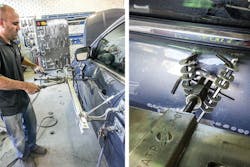HOW IT WORKS:
It’s no secret that the case for repairing versus replacing is an easy one, says Levi Perkins. As the production manager of Rick’s Auto Body in Springfield, Mass., Perkins saw firsthand the amount of quarter panels the shop was replacing every single the day—and the cost of waiting for parts and not keeping everything in house. That’s why, when his tool and equipment representative, Andy Federline, demoed the Miracle System at the shop, Perkins was immediately in.
“As as soon as he demoed it, we knew we had to have it,” says Perkins. “It’s really impressive.”
Miracle System
Website: equipmentgateway.com
YouTube: youtube.com/equipmentgateway
Phone: 1-866-588-7599
Cost: $20,000
Uses: Pulling and pushing dents in quarter panels
Training Required: Two-hour, in-shop training offered by toolmaker
The tool enables the shop to work metal better and save panels that would have needed replacing before. The system uses a welder and a series of aluminum bits (which look like keys). The keys get welded in series along the crease in the panel. Then, a rod is slid through the loop on the keys and allows you to pull the dent out of the panel with the help of various attachments and contraptions.
The system comes with a cart full of attachments, such as a puller, slide hammer and a selection of pulling bits. Additional kits can be purchased for more robust pulling requirements. Although the standard system only works on steel light vehicles and trucks, additional components are available to repair aluminum bodies, as well.
Perkins says the system minimizes strip and refit, and increases labor within each repair job. He says the system also helps maximize cycle time due to the elimination of waiting for panels to arrive.
“There’s a lot of money to be made in repairing the panel, rather than replacing it,” he says. “I would say it makes for a faster repair, too, for turnaround time.”
In addition, Perkins says that setup time is minimal and a technician is quickly able to set up and begin working on the job.
“They pretty much use it every day in our frame department,” he says.
THE RETURN:
First and foremost, Perkins says that the system is helping keep money in house and increase labor hours.
“It allows you to fix panels that you may otherwise have had to replace,” he says. “It’s really about replacing a $700 quarter panel in 12 or so hours, rather than spending $700 on the panel and having to wait on that.”
Perkins conservatively estimates that it will take the shop a year to recoup the cost of the $20,000 system.
